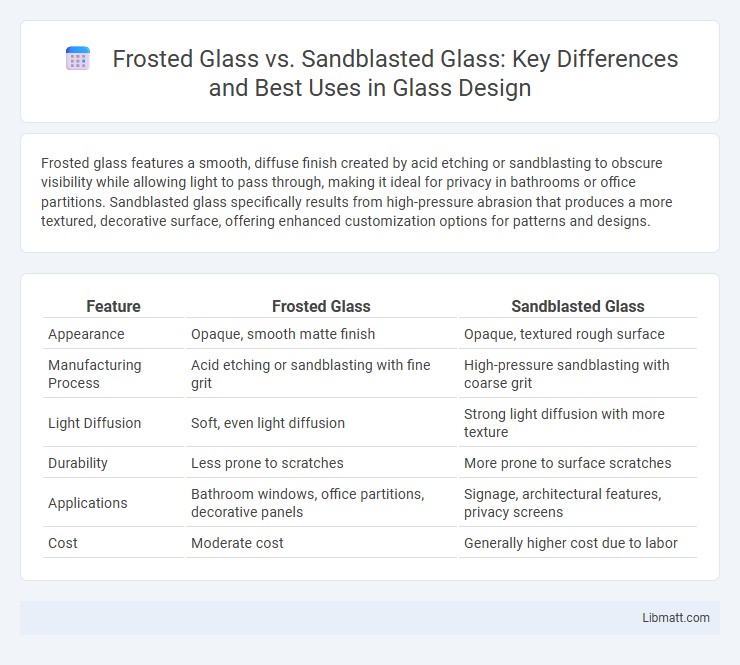Frosted glass features a smooth, diffuse finish created by acid etching or sandblasting to obscure visibility while allowing light to pass through, making it ideal for privacy in bathrooms or office partitions. Sandblasted glass specifically results from high-pressure abrasion that produces a more textured, decorative surface, offering enhanced customization options for patterns and designs.
Table of Comparison
| Feature | Frosted Glass | Sandblasted Glass |
|---|---|---|
| Appearance | Opaque, smooth matte finish | Opaque, textured rough surface |
| Manufacturing Process | Acid etching or sandblasting with fine grit | High-pressure sandblasting with coarse grit |
| Light Diffusion | Soft, even light diffusion | Strong light diffusion with more texture |
| Durability | Less prone to scratches | More prone to surface scratches |
| Applications | Bathroom windows, office partitions, decorative panels | Signage, architectural features, privacy screens |
| Cost | Moderate cost | Generally higher cost due to labor |
Introduction to Frosted and Sandblasted Glass
Frosted glass is created by acid etching or sandblasting the surface to produce a translucent, matte finish that diffuses light while maintaining privacy. Sandblasted glass specifically involves blasting the glass with fine abrasive particles to create a finely textured, opaque surface ideal for decorative and functional applications. Both techniques enhance aesthetics and privacy but differ in texture and production methods, influencing their use in architectural and design projects.
What is Frosted Glass?
Frosted glass is created by acid etching or sandblasting the surface of clear glass to produce a translucent, matte finish that diffuses light while maintaining privacy. This treatment gives the glass a smooth, opaque appearance ideal for bathroom windows, office partitions, and decorative panels. Your choice of frosted glass enhances aesthetics and functionality by allowing natural light to enter spaces without compromising on privacy.
What is Sandblasted Glass?
Sandblasted glass is created by propelling fine abrasive materials at high pressure onto the glass surface, producing a smooth, opaque finish that diffuses light while maintaining privacy. This technique allows for precise patterns and designs to be etched into the glass, making it popular for decorative applications. Unlike frosted glass, which is chemically treated or acid-etched, sandblasted glass offers a more uniform texture and can be customized with intricate artwork.
Frosted vs Sandblasted Glass: Appearance
Frosted glass features a uniform, matte finish achieved by acid etching that diffuses light softly, providing a smooth and consistent look. Sandblasted glass has a textured, slightly rough surface created by high-pressure sand particles, offering more tactile depth and subtle patterns. Your choice depends on whether you prefer the sleek uniformity of frosted glass or the tactile visual interest of sandblasted glass for your space.
Durability and Maintenance Comparison
Frosted glass, created through acid etching, offers a smooth, matte finish that resists scratches and is easy to clean, requiring only mild detergents and regular wiping to maintain clarity. Sandblasted glass, produced by blasting abrasive materials onto the surface, provides a textured, frosted appearance but can be more prone to damage from abrasive cleaning methods, necessitating gentle care to avoid surface wear. Both types are durable for indoor applications, but frosted glass generally demands less maintenance due to its uniform surface resistance to dirt and scratches.
Light Diffusion and Privacy Levels
Frosted glass offers uniform light diffusion by etching the surface to scatter light evenly, maintaining a balance between brightness and privacy ideal for office partitions or bathroom windows. Sandblasted glass provides a more textured, opaque finish that enhances privacy by significantly reducing visibility while still allowing natural light to penetrate. Both options effectively diffuse light, but sandblasted glass offers superior privacy levels suited for areas demanding minimal transparency.
Common Applications and Uses
Frosted glass is commonly used in office partitions, bathroom windows, and shower enclosures to provide privacy while allowing natural light to filter through. Sandblasted glass is frequently applied in decorative panels, signage, and architectural features due to its ability to create intricate designs and patterns with a smooth, matte finish. Your choice between frosted and sandblasted glass depends on whether you prioritize simple light diffusion or detailed aesthetic customization.
Cost Differences: Frosted vs Sandblasted Glass
Frosted glass typically costs less than sandblasted glass due to simpler production methods involving acid etching or film application, making it a more budget-friendly option for your projects. Sandblasted glass requires specialized equipment and skilled labor to create detailed, custom designs by blasting fine abrasive materials onto the surface, driving up the price. Choosing between frosted and sandblasted glass depends on your budget constraints and the level of design intricacy you desire.
Pros and Cons of Each Glass Type
Frosted glass offers a smooth, elegant appearance with excellent privacy and easy maintenance but may show fingerprints and scratches more easily than sandblasted glass. Sandblasted glass provides a textured, decorative finish that enhances privacy and allows for intricate designs, though it is typically more expensive and can be harder to clean due to its rough surface. Your choice depends on whether you prioritize aesthetic flexibility and durability or ease of upkeep and cost-effectiveness in your space.
Choosing the Right Glass for Your Project
Frosted glass offers a smooth, consistent opacity ideal for modern aesthetics and privacy, while sandblasted glass provides a textured, matte finish with more intricate design possibilities. Your choice depends on the desired level of translucency, maintenance needs, and the specific style of your space. Evaluating these factors ensures you select the perfect glass type that enhances both function and visual appeal in your project.
frosted glass vs sandblasted glass Infographic

 libmatt.com
libmatt.com